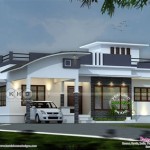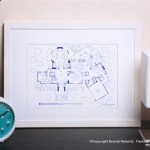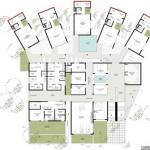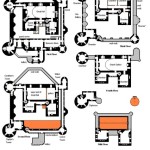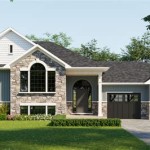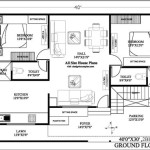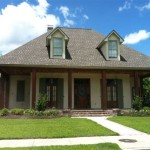The Change Up House Floor Plan: Adaptability in Residential Design
The "change-up" house floor plan, sometimes referred to as a flexible or adaptable floor plan, represents a design philosophy that prioritizes future modification and versatility within a residential space. It acknowledges that homeowner needs and lifestyles evolve over time, necessitating alterations to a home's layout. Unlike traditional floor plans that are often rigidly defined, the change-up approach incorporates elements that facilitate relatively easy and cost-effective reconfiguration, catering to changing family sizes, evolving work habits, accessibility requirements, and shifts in lifestyle preferences.
The fundamental concept behind a change-up floor plan is to anticipate potential future needs and integrate design features that allow for internal alterations without requiring extensive or costly construction projects. This can include the incorporation of non-load-bearing walls, strategically placed utility access points, easily reconfigurable spaces, and the use of modular design elements. The objective is to create a home that can readily adapt to new requirements while minimizing disruption and maximizing long-term value.
The increasing popularity of change-up floor plans reflects a growing awareness among homeowners of the importance of future-proofing their investments. Factors contributing to this trend include increased longevity, the rise of remote work, the desire to accommodate aging parents or adult children, and the growing emphasis on sustainable and adaptable living environments.
Key Point 1: Structural Considerations and Non-Load-Bearing Walls
One of the core elements of a change-up floor plan is the strategic use of structural design to minimize the number of load-bearing walls within the interior space. Load-bearing walls provide critical support for the roof and upper floors and are significantly more challenging and expensive to modify or remove. By minimizing the reliance on these walls, the floor plan gains inherent flexibility.
In change-up designs, interior walls are often constructed as non-load-bearing partitions. These walls primarily serve to define spaces and provide privacy but do not contribute to the structural integrity of the building. This allows them to be easily removed, relocated, or reconfigured without compromising the overall stability of the home. Construction of non-load-bearing walls can employ various techniques, including standard stud framing, modular wall systems, and even temporary partition solutions. The choice of construction method depends on factors such as budget, desired level of acoustic performance, and the anticipated frequency of future modifications.
The support for the upper floors and roof in a change-up design is often provided by a network of beams and columns strategically placed to minimize obstruction and maximize open space. This structural framework can be concealed within the walls and ceilings, creating a clean and modern aesthetic while simultaneously providing the necessary support and allowing for significant flexibility in interior layout.
Furthermore, the strategic placement of support columns can delineate areas that can easily be subdivided based on future occupant need. For instance, a large open-plan living space could easily be sectioned off by adding walls between the columns, creating additional bedrooms or a home office without compromising the structural integrity of the building.
Key Point 2: Flexible Spaces and Multi-Functional Rooms
Another essential feature of the change-up floor plan is the design of flexible spaces that can be easily adapted to serve multiple purposes. Instead of designating rooms for single, specific functions, these spaces are designed with versatility in mind, allowing them to be used as living rooms, dining areas, home offices, guest rooms, or playrooms, depending on the current needs of the occupants.
This multi-functionality is often achieved through the use of open-plan layouts, which create large, undivided spaces that can be easily reconfigured with furniture, screens, or temporary partitions. Open-plan layouts promote a sense of spaciousness and connectivity while also providing the flexibility to adapt the space to different uses. This can be particularly beneficial for smaller homes where maximizing space efficiency is crucial.
The design of flexible spaces also involves careful consideration of lighting, electrical outlets, and data connections. Strategically placed outlets and data ports allow for easy access to power and internet connectivity, regardless of how the space is configured. Similarly, adjustable lighting systems can be tailored to suit different activities, from working at a desk to relaxing in the evening. The inclusion of dimmer switches and multiple light sources enables occupants to create the desired ambiance for any given situation.
Storage solutions also play a vital role in the functionality of flexible spaces. Built-in shelving units, modular storage systems, and hidden storage compartments can help to keep the space organized and clutter-free, regardless of how it is being used. These storage solutions can be easily reconfigured or relocated as needed, further enhancing the adaptability of the space.
Key Point 3: Utility Infrastructure and Accessibility Considerations
The successful integration of utility infrastructure is critical to ensuring the adaptability of a change-up floor plan. The strategic placement of plumbing, electrical, and HVAC systems can greatly simplify future renovations and modifications, minimizing the cost and disruption associated with relocating these essential services.
In change-up designs, plumbing fixtures are often grouped together in central locations, such as near existing bathrooms or kitchens. This reduces the cost of adding new bathrooms or relocating kitchen appliances in the future. Similarly, electrical panels and wiring are designed with excess capacity and planned for future expansion. This allows for the easy addition of new circuits and outlets without requiring major rewiring.
The layout of HVAC systems is also carefully considered to ensure that heating and cooling can be efficiently distributed throughout the house, regardless of the configuration of interior spaces. Ductwork is often designed with additional branches and dampers that can be easily adjusted to accommodate changes in room size or layout. Zoned heating and cooling systems can also be implemented to allow for individual control of temperature in different areas of the house.
Accessibility considerations are also integral to the design of a change-up floor plan. Incorporating features such as wider doorways, barrier-free entrances, and adaptable bathrooms can make the home more accessible to people of all ages and abilities. These features not only enhance the quality of life for occupants with disabilities but also increase the resale value of the home. Universal Design principles can be incorporated to address these concerns, ensuring the home can be adapted to future needs related to aging in place.
Specifically, wider doorways (typically 36 inches) allow for wheelchair access and easier movement of furniture. Barrier-free entrances eliminate steps or thresholds that can be difficult to navigate for people with mobility limitations. Modifiable bathrooms can include features such as grab bars, adjustable-height countertops, and roll-in showers. Integrating these accessibility features from the outset is significantly more cost-effective than retrofitting them later.
In conclusion, the change-up house floor plan represents a paradigm shift in residential design, prioritizing adaptability and future-proofing over rigid, fixed layouts. By incorporating features such as non-load-bearing walls, flexible spaces, and strategically placed utility infrastructure, these plans provide homeowners with the ability to easily adapt their homes to meet their evolving needs and lifestyles.

Exciting House News A Change In Floor Plans Addicted 2 Decorating

Jason Bateman S House In The Change Up Hooked On Houses

Charming Raspberry Cottage By William E Poole Designs

Pin On Cabin

Floor Plan Creator And Designer Free Easy App

What To Know Before You Change Your Home S Layout Realty Times

House Plans How To Design Your Home Plan

Pin On Plantas Dist

12 Examples Of Floor Plans With Dimensions

Barn Plan 2 810 Square Feet 3 Bedrooms Bathrooms 963 00625

